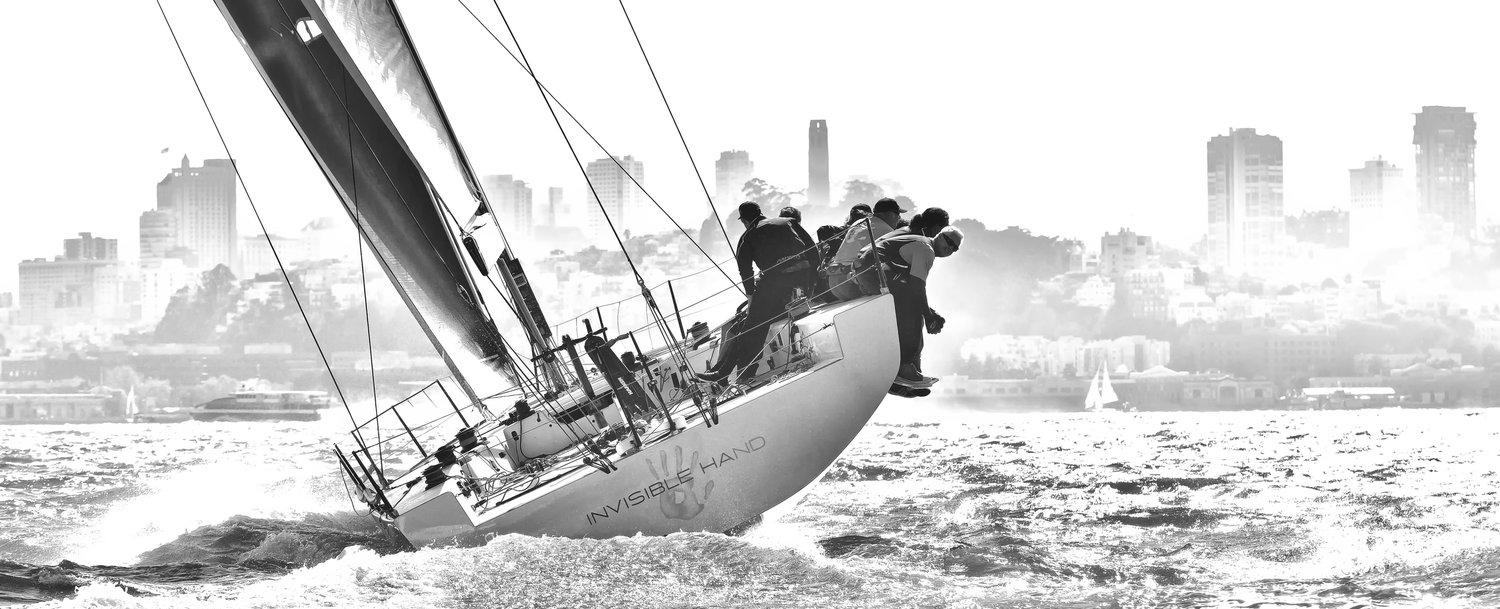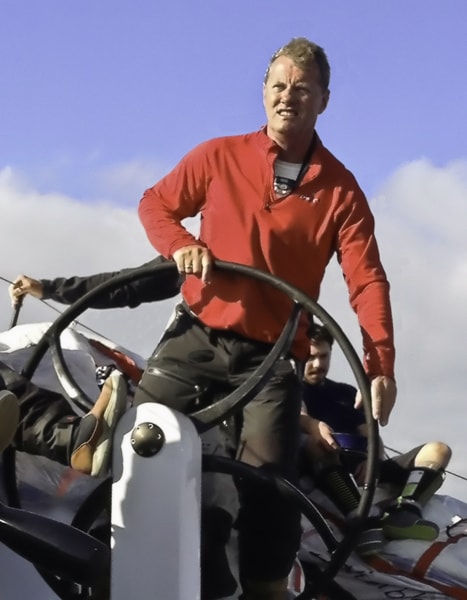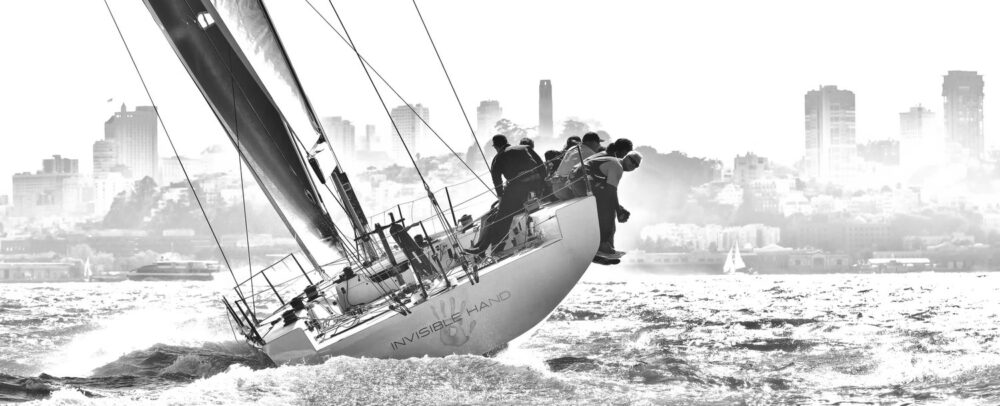Load the article here or read online http://bit.ly/2VmGBPe
A sport with Dutch roots: “Regatta racing is the only thing that completely unplugs my mind from business pursuits,” says San Francisco Bay Area resident Frank Slootman, Pac52 fleet co-founder and owner of the Invisible Hand, hull two designed by Judel/Vrolijk and built by Cookson in New Zealand. A native of Huizen in Holland, this Netherlands School of Economics graduate, Erasmus University Rotterdam, reveals his passion for building companies to be as strong as his passion for developing winning crews.
He’s helmed various yachts, including a Reichel/Pugh 63, the Invisible Hand (first to finish 2014 Pacific Cup, first in division 2015 Newport Beach to Cabo San Lucas), his J/111 also named Invisible Hand, plus a J/70 Little Hand. His newest investment in Pac52 silver, plus leadership role building the West Coast (United States) fleet, seem destined to yield top dividends. A good luck talisman adorns all his vessels—skipper claims an invisible hand has been aiding him in business and racing.
Hitting the Fleet Start Line with Dutch Roots
The Pac52 yacht made a splash in 2016 when Victor Wild’s Fox appeared at the Rolex Big Boat Series, San Francisco. Stacked against six other vessels, Wild’s crew handily earned both an ORR A division win, plus St. Francis Yacht Club Perpetual Trophy. Fox became the talk on the regatta course, and new fleet discussions quickly ensued within a small circle of individuals. That circle included Slootman, who asserts fleet formation heralds a return to West Coast grand prix racing.
Long frustrated by a lack of larger boat One Design competition in the region, he shares, “We wanted to sail on a grand prix platform and compete boat-for-boat, so timing was excellent for the Pac52. Handicap racing wasn’t for us anymore, and we had tried competitive smaller boat action with J/70 and C&C 30 divisions.” Sources say the last comparably sized fleet to actively campaign on the West Coast has been the Farr 40, but in recent years its numbers have declined. Currently tracking fewer than 10 crews, and with most events hosted scattered around the U.S., timing was ripe for a sexy new design on the West Coast.
He continues, “Developing this fleet is similar to developing a start-up in that we wrapped a year one championship with only six boats on the line. Our objective is to grow, and the best thing we can do is get out and race. Once people see the boats go at it on the water, the question becomes how do I get in?” Simply being seen is a key tactic for attracting participants.
“It’s not that different from what we do in business: when you have a good product, the challenge becomes how to create exposure for it.” The fall championship attracted new competitors Beau Geste, skippered by Karl Kwok of Hong Kong, and Gladiator, owned by Tony Langley of Great Britain. They were joined by southern California boats Fox, Manouch Moyashedi’s Rio and Tom Holthus’s BadPak, plus northern California’s Invisible Hand.
Speaking of affinities, Slootman illustrates how sailing and business can go hand-in-hand: “The intensity and competitive nature of racing often resemble what goes on in business, which explains why we are drawn to it. But sailing helps us balance out, regain perspective, and perhaps give more longevity to our business lives. Business can be an all-consuming endeavor.
Sailing provides that escape, if only for a while.” On a tactical level, business and sailing trigger the same reflexes. He adds, “We become obsessed with attracting and retaining talent, we leave no stone unturned to make our boats faster, and we are single-minded in our goal of winning. We are not out there for a cruise, or a social experience. We leave it all on the race course.” Punctuating his thoughts, “I sail because it is in my blood.”
Sailing as Metaphor for Business
Pac52 design elements are similar to those of a Super Series yacht, notably a hull shape identical to the newest TP52 model. However, the Pac52 vessel has a lighter engine, taller mast and deeper foils which necessitate a slightly larger sail area of 4,000 square feet (main, headsail, spinnaker). The Pac52 will plane in downwind conditions, easily reaching speeds well over 20 knots in down wind in breeze. The highest speeds clocked to date on Slootman’s vessel are 25-26 knots, but sources say higher rates are possible.
Vessels are a bit more stable than Mediterranean circuit yachts, and are designed for conversion between inshore and offshore-modes. An inshore event requires crew of 14; offshore requires 10. Some boats will compete in ocean racing; Invisible Hand and BadPak both entered the 2017 Transpac to Hawaii.
A businessman with a penchant for success, sailing is inextricably woven into this executive’s world, and vice versa. Only recently did Slootman step aside as President and CEO of ServiceNow; he retains the role Chairman of the Board. “Sailing is often a perfect metaphor for business: it combines competition, technology, elements of risk, tactics and strategy into a winner-takes-all game. In fact, I think my employees sometimes got exhausted hearing me use sailing examples to explain business concepts.”

Silicon Valley Pedigree
Slootman has also worked with Silicon Valley powerhouses Compuware Corporation and Borland Software Corporation. In the 2000s he served as President and Chief Executive Officer of Data Domain, Inc. (acquired by EMC in 2009); from 2009 to 2011 he was that company’s President of the Backup Recovery Systems Division. He has even waved a hand at the venture capital world with Greylock Partners, realizing early on the venture capital niche was not an optimal fit for his hard charging temperament and affinity for running companies.
Holland is a nation founded on and aside water. “My dad was a sailor, and I have sat on boats as far back as I can remember. As a young boy growing up on the Ijsselmeer in the 1970s, I recall how Dutch kids were routinely shipped off to sailing schools in the summer. Being on the water was a major pastime for us. There was no Internet, no mobile phones, and television was limited to two state-run channels.
We learned to compete in small boats at very young ages.” Slootman had planned to attend the naval academy, but changed his mind senior year and enrolled at Erasmus University Rotterdam. “I wanted to be an entrepreneur, an executive and an operator.” Upon graduation he did not work in Holland, opting instead to accept a job with Burroughs Corporation in Detroit. “Remaining in Michigan for almost a decade afforded opportunities to sail as crew in many of the Port Huron to Mackinac races, a popular regional regatta where you could usually find me in the back of the boat; as a dinghy sailor I leaned towards sail trim, but for the longer races I preferred to drive.”
Operative word here being ‘drive,’ as in determine the direction for the boat—was this an early indication about his future in business? A wry smile crosses his face, “As in many sports, it helps later in life to have had an early start.”

Growing a Sailing Start-up from Dutch Roots
For a global executive routinely challenged to meet growth—ROI, share price, sales, headcount—what is the interest in growing a sports fleet, especially a fleet that counted just four boats on the line for nearly the entire season? And why get involved in a sports start-up so early in the game, a sailing start-up, no less? “As entrepreneurs, we often build, then end up running companies that grow to thousands of employees.
If truth were told, we enjoyed the early stages of our companies the most—when we were just a small band of brothers,” smiles the skipper. “Sailing brings us back to that extremely direct, hands-on operating environment. Feedback is always instantaneous on the race course, for better or worse. You lose that when your companies become large.”
Leading each Pac52 vessel is a successful business veteran who has navigated the growing pains associated with young companies. “Start-up business ventures are often fledgling and delicate in their early days; and so it is in sailing. One bad rounding, drop or set will take you from ‘hero to zero,’ as the saying goes,” notes Slootman, extrapolating that comparable mistakes in business may bring about a company’s demise.
“What’s different about our start-up is that competitors on the race course turn into partners onshore. We work together. We all promote and build the fleet. At dockside, owners help with repairs, parts, crew, whatever resources need to be shared so that we can get back to the business of racing one another.”
Fleet business may be racing one another, but the reward is winning, and Slootman has sights on 2018. “This winter we are packing up our Invisible Hand C&C30, what we affectionately call ‘Mini-Me’ and which serves as a training platform for the Pac52, and we’ll be practicing out of Fort Lauderdale from January through March.” Edged out by BadPak on the 2017 season overall title (by one point), this racer closes with, “We had spectacular success offshore in 2017, but we have unfinished business inshore.”
